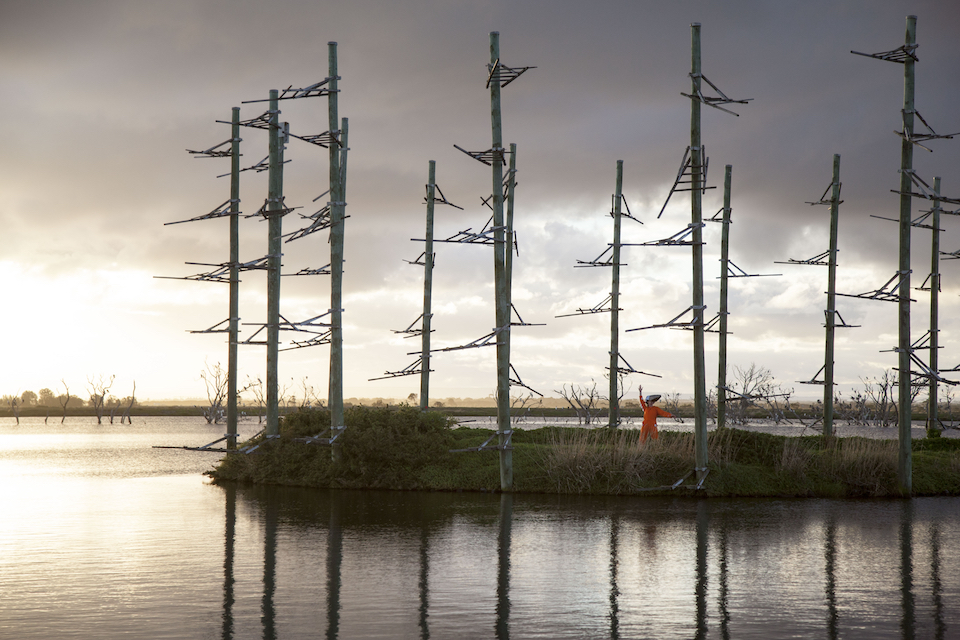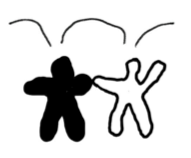
Sightings as part of Treatment 2017: Flightlines, April 2017, Western Treatment Plant, Werribee (Shaun McLeod, Olivia Millard and Ashlee Barton)
On a bad day the smell could be inescapable. But as a location for the performance of Sightings the sewerage treatment plant was sensuously arresting and environmentally rich. This 19th century construction is an enormous stretch of land and water (“almost as big as Cyprus” was the catch cry) carved up into zones, each one a different processing stage (aerobic or anaerobic) eventually leading to clean water. The specific place we chose within the larger site was laid out in a series of vast, rectangular water treatment ponds, situated at the final stages of this sequence. Here we escaped the worst of the smells or the visual assault of churning, brown faecal matter. Here the water seemed clean, the sky was panoramic and the birdlife magnificent as they came and went from the water’s surface. Multiple birds of different species flew overhead, nearby and very far away. There were groups of birds and single, magnificent birds of prey. They flew across the huge sky and they perched and socialized in clumps of dead trees far off in the distance.
Dissecting the water into ponds were thin, uniform strips of reclaimed land (approximately 5-6 metres wide and perhaps 500 metres in length). A road for vehicles circumnavigated the ponds, offering a view for the audience from the bus in which they were transported around the entire public art event. As dancers, the three of us each inhabited a separate strip, rhythmically placed in a line but with significant distance between us. We could see each other but could not hear each other. We stayed on our strips of land for eight hours, eating there, squatting to relieve ourselves and – every 15-20 minutes or so – performing our score for a new bus load of audience members. The three of us were able to see the buses on route in the distance. When one of us would see them, we would alert the others via a text message, and then we would prepare ourselves for their arrival and our next iteration. We kept up this routine over the two days of the project from the morning cool, through the heat of the day and into the picturesque light of the fading day. The second Saturday attracted more people than the first and for a period on that day, it seemed as though as soon as one set of buses had left, another one would arrive. On that day we were performing almost constantly. As each bus drew closer to us along the surrounding road it slowed to a crawl pace and then stopped in front of each strip of land in succession. The audience watched each dancer on their ‘finger’ for a period of time before the bus moved slowly to the next.
The hi-vis orange overalls we wore complied with the regulations for being in the treatment plant (no bare ankles or arms). They also allowed the three of us to be seen from long distances creating a visual cohesion or connection between the three of us and allowing us to be seen as part of the same event. We felt a bit like workers, matching some of the people we had seen who worked in the plant who wore “working” clothes in highly visible colours.
On the central strip of land (Olivia’s) was a bizarre manmade structure of telegraph poles with horizontal perches. The intention in installing these structures, which were ostensibly fake trees, had been to replace the trees that had died and been cut down in the construction and manifestation of the treatment plant; to provide a place for birds to perch. But the birds would have none of it, preferring instead to laze or chatter on the dead trees rising gracefully out of the water. Perhaps they read the trickery (or treachery) of humans and stayed well away. Yet the perches in all their fake-ness had an eerie beauty. Collectively they were like a ghost town which held traces not of memories, but of the futile hopes of people who thought they could in this way atone for environmental destruction and pollution.
In response to this man-made folly, Olivia wore a metre-long bird head which she had constructed out of wire, foam, papier-mâché and paint.
The juxtaposition of man-made uniformity intersecting natural abundance rendered the site conspicuous and contradictory. But the expansive nature of the environment – the sheer scale of it – meant that we, as dancers, did not immediately or readily come into focus. We started as dots on the audience’s horizon. As the bus drew nearer, our presence emerged and took on relevance but initially we were an insignificant feature in a larger picture. In a sense we were ‘competing’ for the audience’s attention; entities at odds with the lack of concern the birds showed for human presence. What we wore, and how we so consciously situated ourselves in this complex site (to aid visibility) was an acknowledgment of the power of the place. It was an (humanist) attempt to place ourselves at the centre of things in a situation that was largely indifferent to our presence or intentions.
Shaun McLeod, Olivia Millard and Ashlee Barton, extract from ‘Sightings’ a chapter from a book (awaiting publication) about Treatment 2017: Flightlines (edited by Cameron Bishop).
Link to Treatment website: http://publicartcommission.com/project/treatment-flightlines-2017
